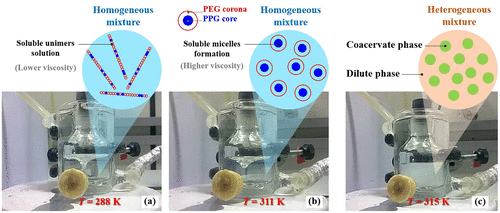当前位置:
X-MOL 学术
›
J. Chem. Eng. Data
›
论文详情
Our official English website, www.x-mol.net, welcomes your
feedback! (Note: you will need to create a separate account there.)
Density, Refractive Index, pH, and Cloud Point Temperature Measurements and Thermal Expansion Coefficient Calculation for PPG400, PE62, L64, L35, PEG400, PEG600, or PEG1000 + Water Systems
Journal of Chemical & Engineering Data ( IF 2.0 ) Pub Date : 2021-06-30 , DOI: 10.1021/acs.jced.0c01092 Leonardo H. de Oliveira 1 , Rafaela R. Pinto 1 , Elias de S. Monteiro Filho 2 , Martín Aznar 1
Journal of Chemical & Engineering Data ( IF 2.0 ) Pub Date : 2021-06-30 , DOI: 10.1021/acs.jced.0c01092 Leonardo H. de Oliveira 1 , Rafaela R. Pinto 1 , Elias de S. Monteiro Filho 2 , Martín Aznar 1
Affiliation

|
Thermophysical properties and phase behavior of seven {polymer (1) + water (2)} systems were determined using PPG400, Ultraric PE62, Pluronic L64, Pluronic L35, PEG400, PEG600, and PEG1000. Density (ρ) and refractive index (n) were measured for the whole range of w1 at T = 293.2 K. Correlation with Redlich–Kister equation and prediction with Lorentz–Lorenz theoretical model were done. pH was measured for different mass fractions at ambient temperature (T ≈ 298.2 K). Cloud point temperature (Tcloud) was measured for different polymer mass fractions (w1) from 0.02 up to 0.30. The thermal expansion coefficient (αT) was calculated for w1 = 0.15 and temperature (T) from 278.2 up to 348.2 K. Experiments were conducted at atmospheric pressure (P ≈ 95 kPa). The obtained thermophysical properties indicate that PEGs + water have the highest ρ while PPG400 + water has the smallest ρ. Also, all ρ vs w1 curves present a maximum value. n profiles are similar for all systems, showing the same refractive index increment for w1 below 0.4. Density (Δρ) and refractive index (Δn) deviations are higher for the PPG400 + water system, mainly due to the highest propylene content and hydrophobic character of PPG units. Moreover, pH varies with polymer mass fraction reaching a minimum value, probably because polymers release H+ in solution. Phase transition results indicate that Tcloud and αT present related behaviors, i.e., when solution became turbid, αT shows an abrupt change in slope.
中文翻译:

PPG400、PE62、L64、L35、PEG400、PEG600 或 PEG1000 + 水系统的密度、折射率、pH 值和浊点温度测量和热膨胀系数计算
使用 PPG 400、Ultraric PE62、Pluronic L64、Pluronic L35、PEG 400、PEG 600和 PEG 1000测定七种{聚合物 (1) + 水 (2)} 系统的热物理性质和相行为。在T = 293.2 K 时,在w 1的整个范围内测量密度 (ρ) 和折射率 ( n ) 。完成了与 Redlich-Kister 方程的相关性和 Lorentz-Lorenz 理论模型的预测。pH值在环境温度下(不同质量分数测量Ť ≈298.2 K)。测量不同聚合物质量分数 ( w 1 ) 的浊点温度 ( T cloud )) 从 0.02 到 0.30。计算热膨胀系数 (α T ) 时w 1 = 0.15,温度 ( T ) 从 278.2 到 348.2 K。实验在大气压 ( P ≈ 95 kPa) 下进行。得到的热物理性质表明PEGs+水具有最高的ρ,而PPG 400+水具有最小的ρ。此外,所有 ρ vs w 1曲线均呈现最大值。所有系统的n分布都相似,对于w 1低于 0.4显示相同的折射率增量。PPG 400 的密度 (Δρ) 和折射率 (Δ n ) 偏差更高+ 水系统,主要是由于 PPG 单元的最高丙烯含量和疏水特性。此外,pH 值随着聚合物质量分数达到最小值而变化,这可能是因为聚合物在溶液中释放 H +。相变结果表明T cloud和α T呈现相关行为,即当溶液变得混浊时,α T显示斜率的突然变化。
更新日期:2021-08-12
中文翻译:

PPG400、PE62、L64、L35、PEG400、PEG600 或 PEG1000 + 水系统的密度、折射率、pH 值和浊点温度测量和热膨胀系数计算
使用 PPG 400、Ultraric PE62、Pluronic L64、Pluronic L35、PEG 400、PEG 600和 PEG 1000测定七种{聚合物 (1) + 水 (2)} 系统的热物理性质和相行为。在T = 293.2 K 时,在w 1的整个范围内测量密度 (ρ) 和折射率 ( n ) 。完成了与 Redlich-Kister 方程的相关性和 Lorentz-Lorenz 理论模型的预测。pH值在环境温度下(不同质量分数测量Ť ≈298.2 K)。测量不同聚合物质量分数 ( w 1 ) 的浊点温度 ( T cloud )) 从 0.02 到 0.30。计算热膨胀系数 (α T ) 时w 1 = 0.15,温度 ( T ) 从 278.2 到 348.2 K。实验在大气压 ( P ≈ 95 kPa) 下进行。得到的热物理性质表明PEGs+水具有最高的ρ,而PPG 400+水具有最小的ρ。此外,所有 ρ vs w 1曲线均呈现最大值。所有系统的n分布都相似,对于w 1低于 0.4显示相同的折射率增量。PPG 400 的密度 (Δρ) 和折射率 (Δ n ) 偏差更高+ 水系统,主要是由于 PPG 单元的最高丙烯含量和疏水特性。此外,pH 值随着聚合物质量分数达到最小值而变化,这可能是因为聚合物在溶液中释放 H +。相变结果表明T cloud和α T呈现相关行为,即当溶液变得混浊时,α T显示斜率的突然变化。











































 京公网安备 11010802027423号
京公网安备 11010802027423号